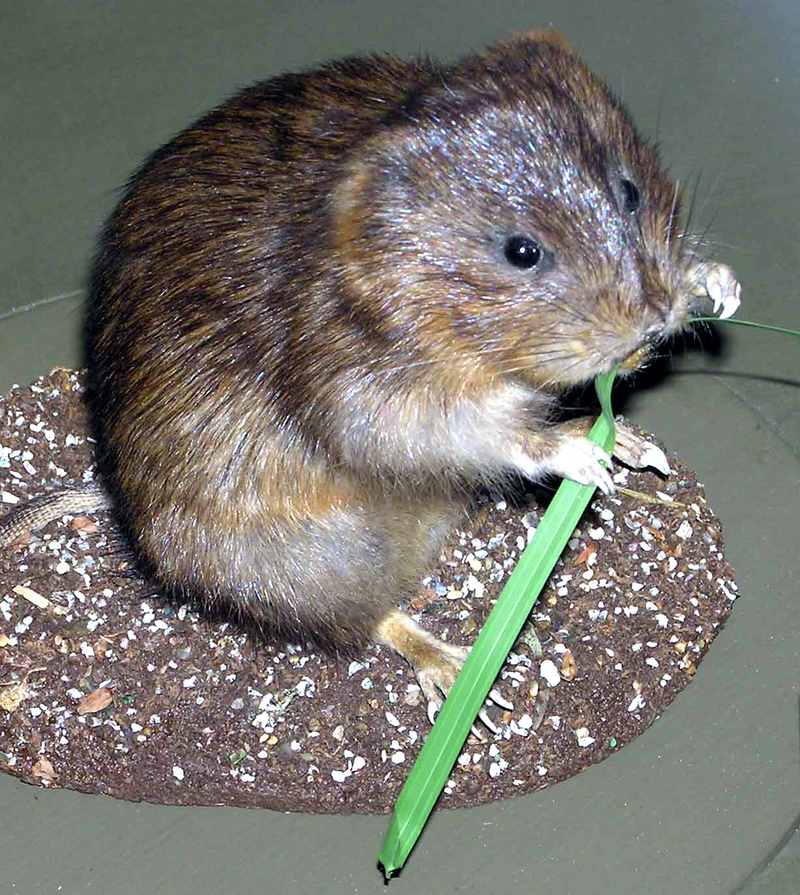European Water Vole (Arvicola amphibius) - Wiki Water Vole
From Wikipedia, the free encyclopedia
[Photo] Water Vole Arvicola terrestris (stuffed) in Bristol Museum, Bristol, England. Taken by Adrian Pingstone in February 2006.
The European Water Vole (Arvicola amphibius or A. terrestris) is a semi-aquatic mammal that resembles a rat. In fact, the water vole is often informally called the “water rat”. Some authorities consider the Southwestern Water Vole in the same species, but it is now generally considered a distinct species. Water voles have rounder noses than rats, deep brown fur, chubby faces and short fuzzy ears; unlike the rat their tails, paws and ears are covered with hair.
In the wild, they survive for 5 months on average, most do not survive a second winter. In captivity, they survive for a maximum of 5 years.
Description
Water voles reach 5???9 inches in length (120???235 mm) plus a tail of 55%???70% of this. Adults weigh from 6???12 ounces (160???350 g), juveniles weigh less but must reach around 5???6 ounces (140???170 g) to be able to survive their first winter.
Species name
The binomial applied to the Water Vole is either Arvicola amphibius or A. terrestris. The confusion stems from the fact that Linnaeus described two species of Water Vole on the same page of the same work. Those two forms are now almost universally considered the same species. Musser and Carleton (2005) recognized A. amphibius (Linnaeus, 1758) as technically correct because the first source to unite the two forms that Linnaeus had treated separately into a single species chose A. amphibius as the valid name. Since A. amphibius and A. terrestris are literally tied in when they were named, priority is determined on the basis of the decision of the first reviewer. This reviewer used A. amphibius to refer to both forms. The name currently in use in Britain is A. terrestris.
Range
The water vole Arvicola amphibius, also known as the Northern water vole, is found in much of Great Britain, northern and central Europe and in parts of Russia.
There is another water vole found in northwestern United States, and southwestern Canada. Some sources classify the North American water vole as a separate species, either Microtus richardsoni or Arvicola richardsoni.
Habitat
In Britain, water voles live in burrows excavated from the banks of calm rivers, ditches, ponds, and streams. They also live in reed beds where they will weave ball shaped nests if no suitable banks exist in which to burrow. In Europe and Russia, they may venture into woods, fields, and gardens. They live under the snow during the winter.
Diet
Water voles mainly eat grass and plants near the water. At times, they will also consume fruits, bulbs, twigs, buds, and roots. In Europe, when there is enough food to last water voles a long time, water vole "plagues" can take place. Water voles eat ravenously, destroying entire fields of grass and leaving the fields full of burrows, during these plagues.
Breeding
The mating period lasts from March into late autumn. The female vole's pregnancy lasts for approximately 21 days. Up to 8 baby voles can be born, each weighing around one fifth of an ounce. The young voles open their eyes three days after their birth. They are half the size of a full grown water vole by the time they are weaned.
Behaviour
Water Voles are expert swimmers and divers. They do not usually live in large groups. Adult water voles each have their own territories, which they mark with a secretion from their bodies. They will attack if their territory is invaded by another vole.
Conservation
The water vole population in the UK has fallen from its estimated pre-1960 level of around 8 million to 2.3 million in 1990 and to 354,000 (other source: 750,000) in 1998. This represents a 90-95% loss. It is still declining dramatically, the most recent estimate for 2004 is around 220,000. This decline is mainly caused by the American Mink, an aggressive predator of the vole, together with unsympathetic farming and watercourse management which destroyed parts of the water vole's habitat.
Consequently, the water vole is the UK's fastest declining mammal and efforts are under way to protect the water vole and its habitat from further destruction. Though much of the official focus on water vole conservation in the UK is on large areas of reed bed which support dense but localised and isolated populations, the largest areas supporting healthy populations of water voles are large conurbations such as Birmingham and London and some upland areas where American Mink are scarce. Across the UK the Wildlife Trusts are undertaking many practical projects to conserve and restore water vole populations.
Water voles have recently returned to Lindow Common nature reserve in Cheshire, UK, after many years of absence. The reserve rangers credit this to conservation management, which included thinning of woodland.
There are also indications that the water vole is increasing in numbers in UK areas where the European otter has made a return. The otter predates on the American Mink.
Trivia
A water vole named Ratty is a leading character in the children's book Wind in the Willows by Kenneth Grahame: the locality used in the book is believed to be Moor Copse.
In the movie and comic novel, Cold Comfort Farm, by Stella Gibbons, one of the characters, Urk, refers to the subject of his unrequited love, Elfine Starkadder, as his little water vole. Throughout the story Urk spends a lot of time talking to the water voles on the farm.
| The text in this page is based on the copyrighted Wikipedia article shown in above URL. It is used under the GNU Free Documentation License. You may redistribute it, verbatim or modified, providing that you comply with the terms of the GFDL. |
